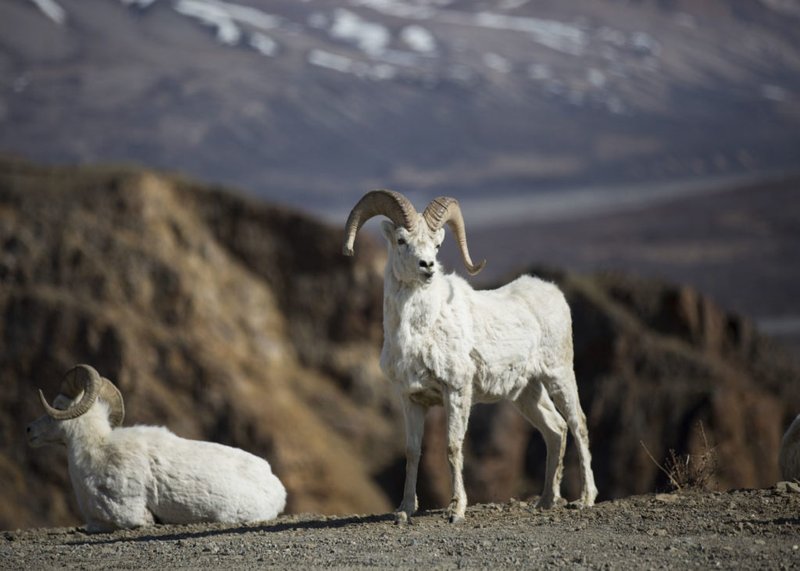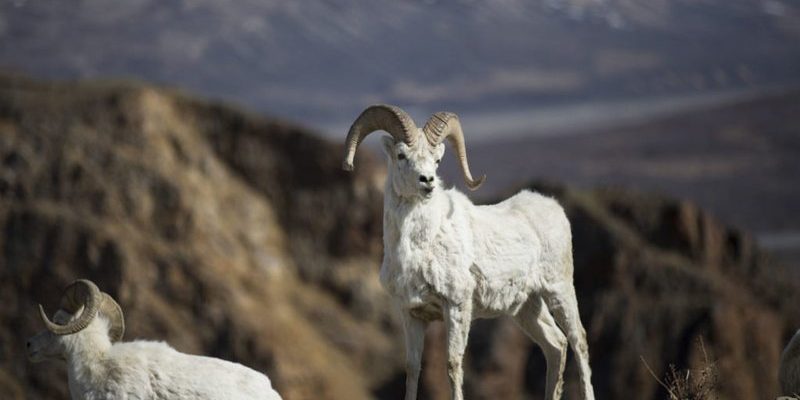
Imagine living in an environment that constantly challenges your survival. The Dall sheep do just that, adapting to life on steep cliffs and rocky terrain. Their agility and unique adaptations make them one of the most captivating species in the wilderness. So, grab your favorite drink, and let’s explore what makes Dall sheep so special!
1. Their Name Has a Unique Origin
The Dall sheep gets its name from the famous naturalist William Healey Dall, who was the first to study the species in the late 19th century. It’s interesting how names can connect us to history, right? Dall was part of an expedition that explored the Alaskan wilderness, and his work helped spark interest in this incredible species. So, the next time you hear “Dall sheep,” you’ll know there’s a whole history behind that name.
They’re also known as “Ovis dalli” in the scientific community. While that may sound fancy, it simply refers to their classification as a species of wild sheep. There are actually two subspecies found in North America: the Dall sheep and the Thinhorn sheep, which thrive in different areas but share many characteristics. The name may have changed, but the animal’s allure remains intact!
2. Exceptional Climbers
If you were to see a Dall sheep in the wild, you might be surprised by how effortlessly they navigate their rocky surroundings. These sheep are natural climbers, thanks to their specialized hooves. With a hard outer shell and a soft, rubbery pad, their hooves provide excellent grip on steep surfaces. Imagine wearing sneakers with just the right tread for climbing mountains—that’s what their hooves do for them!
Dall sheep can traverse steep hills, cliffs, and rugged terrains that would make most animals think twice. They often find safety in these high-altitude hideaways, where fewer predators can reach them. And here’s the thing: their climbing abilities allow them not only to escape danger but also to access food sources that are out of reach for other animals.
3. They Have Impressive Horns
One of the standout features of Dall sheep is their magnificent horns. Male Dall sheep, known as rams, can grow horns that can weigh over 30 pounds and curl into a stunning spiral. It’s like wearing a crown made of bone! Their horns aren’t just for show, though; they serve many essential purposes.
During the breeding season, rams will engage in battles, clashing their impressive horns against each other to establish dominance. These confrontations can be quite dramatic to witness, as they charge at each other with tremendous force. Horns are also a vital part of a ram’s identity, helping to attract females during mating season. Honestly, it’s a wild mix of beauty, strength, and competition all rolled into one!
4. Diet and Foraging Habits
Dall sheep are herbivores, primarily grazing on grasses, herbs, and shrubs. Their diet varies by season, with fresh greens in the summer and tougher plants in the winter. They have a remarkable ability to find food even in the harshest conditions, foraging on rocky cliffs and steep mountainsides.
During the summer months, they can be seen munching on delicious alpine flowers and young plants. In winter, they adapt by scraping through snow to reach the vegetation below. You might think of them as nature’s foragers, always on the hunt for the next tasty meal. This ability to adapt their diet is crucial for surviving in such challenging habitats.
5. Social Structure and Behavior
Dall sheep have a fascinating social structure. They typically live in small groups, often led by a dominant male. These social groups can be composed of females, young lambs, and a few rams. You might be wondering how they decide who leads the pack. Well, it often comes down to experience and strength.
During the breeding season, rams will compete for the attention of females. However, outside of this period, Dall sheep can be quite social, exhibiting various behaviors that help strengthen their bonds. They engage in playful interactions, such as head-butting and chasing each other around, just like kids in a playground. It’s heartwarming to see how social creatures can maintain their bonds in such rugged environments!
6. Their Role in the Ecosystem
Dall sheep play an important role in their ecosystem. As herbivores, they help control vegetation growth, preventing overgrowth and maintaining a healthy balance in their habitat. You could say they’re nature’s lawnmowers—helping keep the mountain landscape in check.
Furthermore, Dall sheep serve as prey for several predators, including wolves, grizzly bears, and mountain lions. This predator-prey relationship is essential for maintaining ecological balance. By understanding their role, we can appreciate how interconnected our natural world is. Each species, including the Dall sheep, contributes to the intricate tapestry of life.
7. Unique Adaptations for Surviving Harsh Conditions
Living in such extreme environments requires special adaptations. Dall sheep have a thick coat of wool that insulates them from freezing temperatures, making them well-suited for life in the cold. You might think of them as nature’s warm coats! This double-layered coat effectively traps heat, allowing them to stay comfortable even during harsh winters.
Additionally, they have excellent eyesight, particularly for spotting potential threats from a distance. Their keen sense of sight helps them stay one step ahead of predators, ensuring their survival in the wild. With these adaptations, Dall sheep embody the resilience needed to thrive in their challenging habitats.
8. Reproduction and Lifespan
The mating season for Dall sheep is quite an event! Rams will compete for the attention of females during this time, often engaging in impressive displays of strength. After a successful mating, the female, known as an ewe, will carry her lamb for about six months before giving birth, typically in late spring.
Lambs are incredibly cute and can stand and walk shortly after birth, which is vital for their survival in such perilous environments. After being born, these little ones must quickly learn to navigate rocky terrains and keep up with the herd. In the wild, Dall sheep can live up to about 10-15 years, but some have been known to reach even older ages in protected environments. Talk about a journey through life!
9. Conservation Status and Challenges
Dall sheep populations face various challenges, primarily due to habitat loss, climate change, and hunting. While they are not currently listed as endangered, their numbers can fluctuate based on environmental conditions. Understanding the importance of conservation efforts is crucial for ensuring that future generations can also appreciate these magnificent animals.
Wildlife management plays a critical role in helping to maintain Dall sheep populations. Conservation initiatives often focus on protecting their habitats and regulating hunting practices to ensure sustainability. Knowing that we can help protect these incredible creatures is empowering, isn’t it? It reminds us that every small action counts toward preserving our natural world.
10. Where to See Dall Sheep in the Wild
If you’re eager to catch a glimpse of these stunning animals, there are several places in North America where you can spot them. Parks like Denali National Park in Alaska and Yukon’s Kluane National Park are known for their healthy Dall sheep populations. Visiting these parks can offer not only a chance to see the sheep but also a breathtaking view of their natural habitats. Just imagine, hiking along a trail and suddenly spotting a group of Dall sheep grazing peacefully on a nearby hillside!
When planning a trip, remember to respect these majestic creatures by observing from a distance. Using binoculars or a camera with a zoom lens can enhance your experience while ensuring the sheep remain undisturbed. So, whether you’re an avid wildlife photographer or simply a nature lover, these parks provide perfect opportunities for you to connect with Dall sheep in their natural home.
In conclusion, the Dall sheep is not just a beautiful animal; it’s a symbol of resilience and adaptation in some of the most challenging environments on Earth. From their unique features to their ecological roles, these creatures have so much to teach us about the natural world. Next time you hear about Dall sheep, you can impress your friends with your insightful knowledge!

